
Our care for students in the fall must be expressed, paradoxically, both by the barriers that we put in place to separate our community and by the measures we take to keep our community connected and welcome. Here are examples of service excellence, hospitality, and care from other sectors that can translate well on our campuses.
by Dr. Heath Boice-Pardee, Associate Vice President for Student Affairs at Rochester Institute of Technology and co-author of Elevating Customer Service in Higher Education: A Practical Guide
As campuses reopen or partially reopen and then continue to adjust throughout the fall, it is paramount that we think carefully about how to provide excellent service to students while social distancing, and about how to show visible and meaningful care for the health and safety of the campus community. While in the past care could be expressed by smiles, handshakes, and even hugs, times have changed. Care must now be expressed by promoting safety measures that have been newly created and implemented. We will all be critiqued on:
- our communication of new policies both before students return to campus and upon their arrival;
- our new cleaning and safety practices; and
- the unexpected but effective ways we can keep our community connected.
This is an unprecedented situation, in which our care for students in the fall must be expressed, paradoxically, both by the barriers that we put in place to separate our community and by the measures we take to keep our community connected and welcome.
Fortunately, we can look to examples of excellent service in the time of COVID-19 from the healthcare and corporate sectors, where clinics and supermarkets have already re-opened, or remained open, successfully. Here are examples of service, hospitality, and care from these sectors that can translate well on our campuses.
Communicating New Policies
Although many colleges and universities are looking to enhance service excellence on and off campus, campus managers can learn from industry leaders known for providing excellent customer service. Such industry leaders include Starbucks, The Disney Company, and Wegmans.
Wegmans is a Rochester, NY based company and is consistently rated as one of the top supermarkets in the country known for providing excellent customer service. Wegmans pioneered – and continues to refine – new and innovative safety measures from the beginning of the COVID-19 pandemic.
A walk through Wegmans can offer several new examples of how to enhance service excellence during amid COVID-19. One of the first hurdles to manage in implementing new safety strategies is delivering communication to customers. Upon entering Wegmans, one of the first things customers see is their store’s policy on wearing face masks. This is key in order to establish expectations for walking around the store.
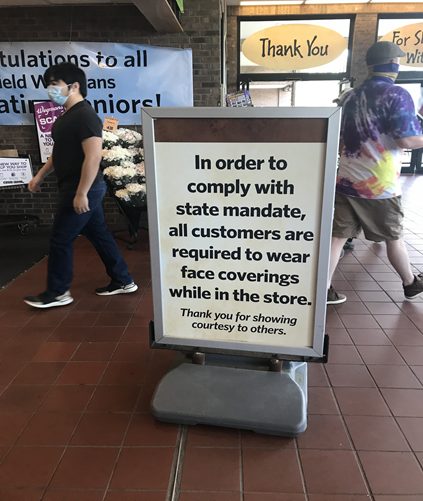
Another highlight of how Wegmans enhanced service and safety are the guidelines they established to maintain lines and checkout. As customers need to follow social distancing practices while waiting in lines at the check-outs and pharmacy, it’s obvious that they will need some guidance on how to line up for service. Wegmans has implemented multiple communications to inform customers how to line-up as well as how to conduct service interactions, including when to approach service areas. Once again strategies include enhanced signage as well as floor markers showing guests where to stand while in line:
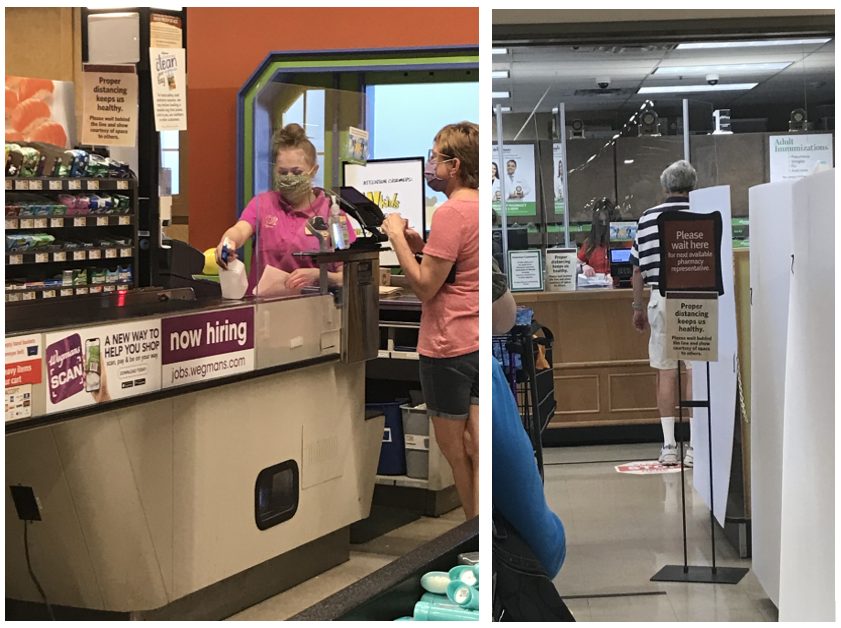
When adding signage on campus, consider the new messages you want to convey to students and others. Your signage should display concise messages that are clear and kind. Clear expectations must be given on guidelines for wearing masks, physical distancing, and practicing good personal hygiene. Surely, adding signage and floor markers measuring six-foot distances between people while standing in line will be beneficial in areas where queues are necessary.
Be mindful, however, that despite your best efforts to add signage and new communications for students, faculty and staff, your intended outcomes may not happen instantly. You are changing the campus culture and that can’t happen through communications and signage alone– you will need to be ready to remind people about new guidelines in person, and even to manage individuals who do not follow your directives. Not having procedures in place to handle situations when individuals are not wearing masks or practicing physical distancing can lead to negative service experiences for others.
Although managing confrontations related to quickly-changing health codes are beyond many of our areas of expertise, providing clear consequences for non-compliant students, faculty and staff is crucial. If a staff member sees a student in a lounge without a mask, what is the expectation? Should the staff address the student or call someone else to do it? What if masks are required in classrooms but a student doesn’t comply? What is the protocol the faculty member should follow? Planning for these potential confrontations, and communicating your expectations, will provide for easier resolution that can be managed safely.
New Cleaning Practices: Showing Care through Disinfectant
There aren’t student development theories around sanitization, however during the pandemic we all need to pitch in to practice, and role model, enhanced cleaning measures on-campus. Considering Wegmans again. Another measure quickly seen upon entering the stores are carts of sanitizing wipes and hand sanitizer.
One important but often neglected detail related to this involves providing trash receptacles where wipes or paper towels can be discarded. Without them, what are individuals supposed to do with the dirty wipes? Without available and prominent trash cans, these items will quickly become trash strewn around hallways, public spaces, and outside, which creates other sanitation issues.
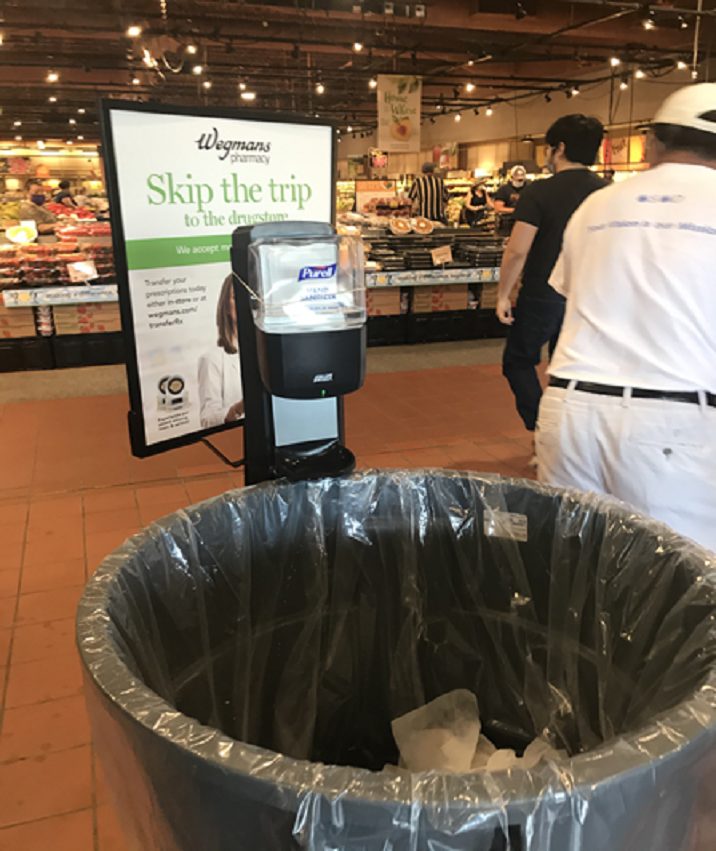
Wegmans has also implemented the use of sanitation carts. Employees walk around the stores with these carts equipped with cleaner and wipes, wiping down surfaces throughout the store. While this extra cleaning measure enhances the store’s safety for employees and guests, there is also an additional benefit. The sanitation cart is a mobile advertisement for the care that Wegmans has taken to provide for employee and guest safety:
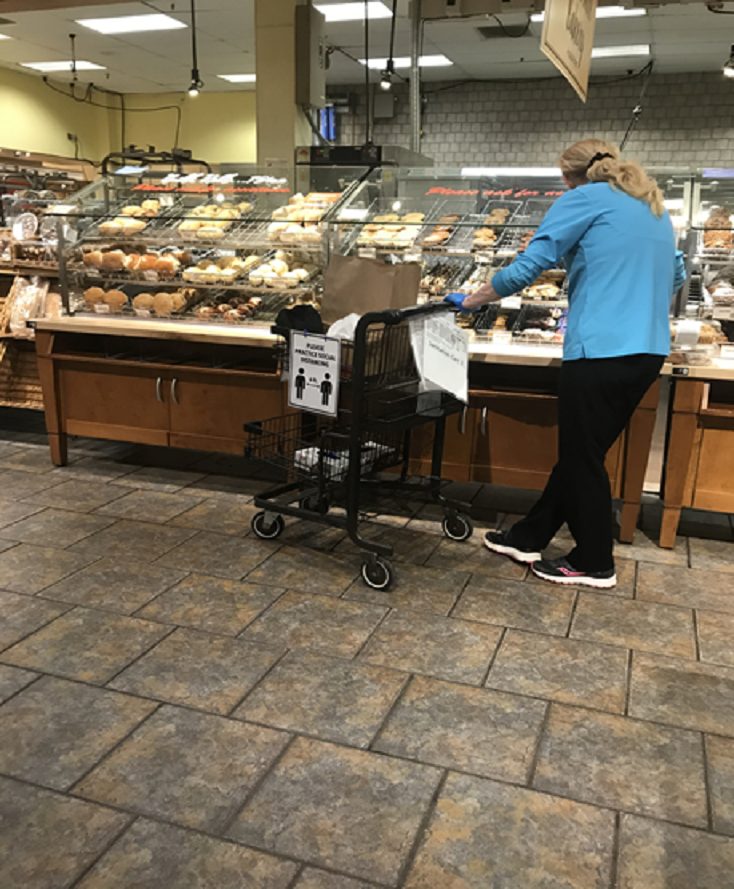
Similarly, at an institution of higher education, consider how you will make sanitization and cleaning products not only available but also visible in public spaces. In addition to hand-sanitization stations in high traffic areas, when a student finishes sitting at a table, should they use a sanitizing wipe that you provide to clean the table, or will you have a staff or student worker handle this important task? Likewise, cleaning counters, desks, and public tables will be needed after each interaction (which is the practice at Wegmans).
Additionally, think about common items such as cups of pens, staplers, hole-punchers, and more items that are shared commonly within departments. These should be removed, unless a plan for sanitization after each use is developed. The same holds true for jars of candy sitting on desks, brochures and magazines in waiting areas, etc. All of these should be removed in order to limit touch-points in office areas and lounges on campus.
Staying Connected while Distancing
The first time I went to the supermarket during the pandemic, I was struck by the fact that I couldn’t see people’s faces. I couldn’t recognize friends, and even if I thought I did, I was unsure if I was correct. No one wants to enthusiastically greet our friend Tina, only to find that Tina is Tonya. Think about this on campus. Especially for new students who have just met other students, faculty, and staff, how are they going to nurture budding relationships if they aren’t sure that they are approaching the right person? Will they be able to recognize new acquaintances by unique masks? What happens when the masks need to be taken off and washed?
One strategy to mitigate being socially inconspicuous is to encourage everyone on campus to wear a “facetag.” This is a tool started during the pandemic by many healthcare professionals who began wearing photos of themselves to show what they look like behind the mask. This is a perfect way to communicate care, presenting a warm likeness (a photograph of a smiling face) instead of only a covered face.
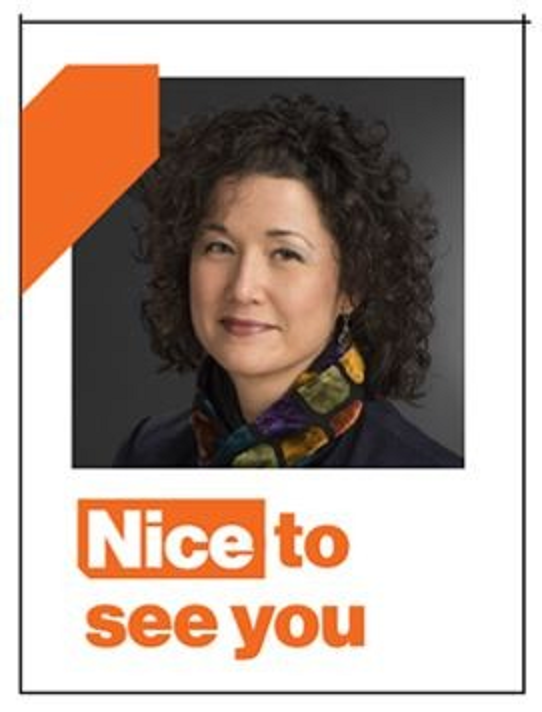
Since this has proven useful in healthcare settings, consider crafting facetags for faculty, staff, and even student ambassadors such as orientation leaders and resident assistants. These facetags would show faces and even display messages that convey caring sentiments such as, “Nice to see you,” or, “Can I help you?” Facetags can be printed on any color printer and easily inserted into plastic holders clipped to existing nametags or as standalone badges, or can be worn on lanyards.
We all have to be creative about staying connected while social distancing. Additional ideas include:
- arranging lounge furniture in socially distanced ways so that students and others can still meet in person;
- adding outside seating, six feet apart, in conversational groupings to encourage socializing; and
- replacing queues wth lounge seating.
Consider areas where you use queues on campus. In one area on my campus, we are forgoing the usual need for a line and are instead using the space for lounge seating. Students will check in and then sit comfortably outside of the office. This way, we can accommodate the same number of students in a socially distant and much more relaxing way.
Final Thoughts
Although for most of us it seems as if the world has been turned upside down, it’s important to note that the what and the why of service excellence hasn’t changed—just the how. We still need to be guided by service principles such as being responsive, providing care, and exceeding expectations. These, with an added emphasis on providing for safety, are more crucial than ever. If we follow these principles, and if we let a commitment to service guide our policies, signage, and strategies to keep faculty, staff, and students physically distant yet socially connected, our campus community will appreciate and remember it for years to come.
Heath Boice-Pardee, EdD is Associate Vice President for Student Affairs at Rochester Institute of Technology. He is co-author of the book, Elevating Service Excellence in Higher Education: A Practical Guide. He can be reached at hbpvsa@rit.edu.
______________________________
Image credits: The photo at the top of the page is by Anshu A on Unsplash. All other photos by Heath Boice-Pardee.
______________________________
Get the Book
Boost your department’s standard of customer service.
Elevating Customer Service in Higher Education provides an in-depth guide by three practitioners with decades of combined experience in the higher education and hospitality sectors. Our authors are deeply embedded in customer service initiatives and have certified hundreds of higher-ed professionals at Academic Impressions’ customer service trainings and on-campus workshops.
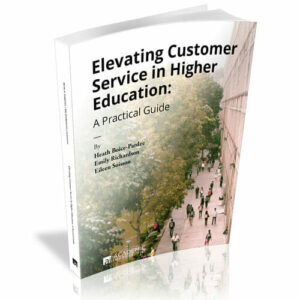
“The book provides the basics of academic customer service in a very considered and practical guide by pulling on some of the best work in service excellence, academic customer service, and business practices. It provides the background needed to engage in customer service on campus and initiate the thinking necessary to begin setting up a service excellence program. It should be read by every administrator who cares about retention and service excellence.”
Neal Raisman, N. Raisman & Associates “How refreshing and encouraging it is to read a book about customer service on today’s college campuses. Customer service can no longer be viewed as a negative concept on our campuses. Rather, such service is mandated today… Implementing such measures that change a campus’s culture may mean the difference between those colleges that survive and those that do not. The foundations of quality service discussed in this book should be mandatory reading for all college administrators.”
David DeCenzo, President, Coastal Carolina University


